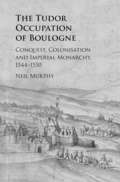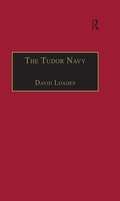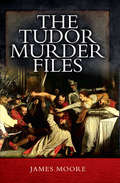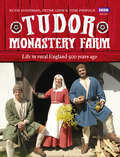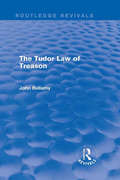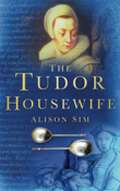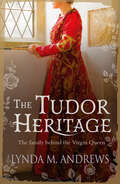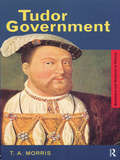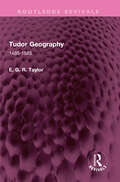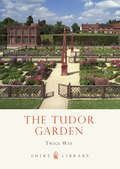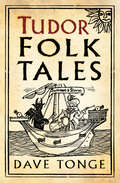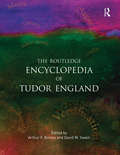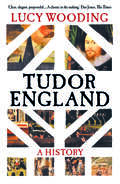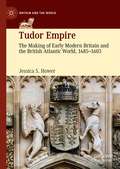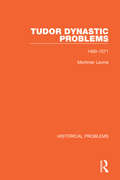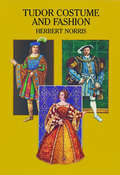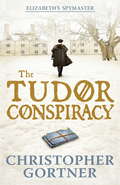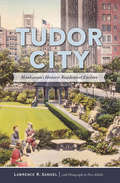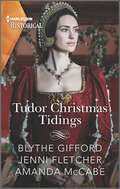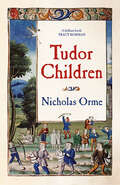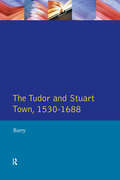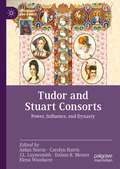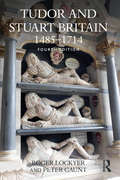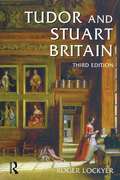- Table View
- List View
The Tudor Occupation of Boulogne: Conquest, Colonisation and Imperial Monarchy, 1544–1550
by Neil MurphyIn 1544, Henry VIII led the largest army then ever raised by an English monarch to invade France. This book investigates the consequences of this action by examining the devastating impact of warfare on the native population, the methods the English used to impose their rule on the region (from the use of cartography to the construction of fortifications), as well as the development of English colonial rule in France. As Murphy explores the significance of this major financial and military commitment by the Tudor monarchy, he situates the developments within the wider context of English actions in Ireland and Scotland during the mid-sixteenth century. Rather than consider the plantations established in the mid-sixteenth century Ireland as the 'laboratory' for a new form of empire, this book argues that they should be viewed along with the Boulogne venture as the English crown's final attempt to establish colonies through the use of state resources alone.
The Tudor Navy: An Administrative, Political and Military History (Ucl Institute Of Archaeology Publications)
by David LoadesThe Tudor Navy is a subject which is very unevenly known. The last significant general histories were written at the end of the last century. Since then much detailed research has been undertaken, particularly on the Armada, the end of Henry VIII's reign and the early Elizabethan period. As a result, it has been generally thought that the navy went through a series of booms and slumps during the sixteenth century. Further research on the intervening periods now presents a much more even picture of development, although the pace of advance was uneven. At the same time naval history has tended to be seen in isolation, presented by special naval experts. It is better understood as a part of the general administrative, political and above all financial history of the period. This book is designed to present a whole story, set in its proper contemporary context.
The Tudor Murder Files
by James Moore&“Collates the most shocking killings and puzzling murder mysteries from the sixteenth century in fascinating detail&” —Gazette & Herald In the Tudor age the murder rate was five times higher than it is today. Now, this unique true crime guide, The Tudor Murder Files, reveals just how bloody and brutal this fascinating era really was. From the dark days of Henry VIII to the turbulent times of Shakespeare, James Moore&’s new book is the first to chart the period&’s most gripping murder cases in all their grizzly detail. Featuring tales of domestic slaughter, sexual intrigue, and cunning assassinations, as well as murder mysteries worthy of Agatha Christie, the book vividly brings to life the violent crime wave that gripped the sixteenth century both at home and abroad. Enter a world in which stabbings were rife, guns were used to kill victims for the first time, and in which culprits frequently escaped justice. The book also reveals just how severe some of the penalties could be, with grisly punishments for those who dared to commit the gravest of crimes. Discover how one murderer was gruesomely pressed to death, another boiled alive for poisoning his victims, and meet some of history&’s most notorious serial killers, including one considered so barbaric she was labelled a vampire. &“Contains more than seventy real life murders, profiling over thirty cases in detail. And not only does James chart how killers were caught and dealt with by the justice system, he also discusses how murders were reported to the new, news hungry nation.&” —Luton Today
Tudor Monastery Farm: Life in rural England 500 years ago
by Peter Ginn Ruth GoodmanRuth Goodman and Peter Ginn have become familiar faces on BBC2 after their hugely popular and immersive time-travelling experiments, Victorian, Edwardian and Wartime Farm. But for their fourth series, and our accompanying book, they have joined forces with Tom Pinfold to take on their biggest challenge yet: going back to Tudor England to endure the harsh realities of working for an Abbey Farm.Peter, Ruth and Tom are trained historians, driven by new research and discovery. They are passionate about bringing period details to life, and they do that for us by comprehensively inhabiting the era for months, using only materials, tools and technology available at the time, to earn their living, celebrate their holidays, clothe and feed themselves and their families. Follow them as they discover how to build a pigsty, brew their own ale, forge their own machinery and keep a Tudor household. Scrupulously researched, totally authentic and with its own contemporary narrative playing out within an accurate reconstruction of Tudor England, this is a fantastic glimpse into history, as it was lived. This is set to be Peter, Ruth and Tom’s most ambitious historical assignment yet.
The Tudor Law of Treason: An Introduction (Routledge Revivals)
by John BellamyThis title, first published in 1979, was ground-breaking in its exploration of the understudied area of the Tudor law of treason. Bellamy first examines the scope of that law, noting the inheritance from the Middle Ages, the effectiveness of the new statutes and interpretation of the law by the judiciary. Mining the archives for official, legal and literary accounts, the following parts consider how the government came to hear of traitors, the use of evidence and witnesses in trials and finally the fate of the traitor at the gallows and beyond. This is a full, useful and interesting title, which will be of great value to students researching Tudor and late medieval statute law, the Tudor concept of treason and the mores of Tudor society.
The Tudor Housewife
by Alison SimThe political and military history of the sixteenth century is well known, and much written about, but what of the thousands of women who have, for the most part, eluded the historian's pen? The Tudor Housewife aims to answer this question, providing a unique and accessible introduction to everyday life and responsibilities of women from all levels of society in the age of Henry VIII and Elizabeth I. With chapters on marriage, childbirth, the upbringing of children, washing and cleaning, food and drink, the housewife as doctor, women and business, and women and religion, Alison Sim reveals how women were expected to manage businesses as well as the household accounts, take extensive personal interest in the moral welfare of their children, adminster medicine to their households and act as a helpmeet to their husbands in every aspect of life. This book unveils the powerful position of ordinary women in Tudor society and provides a captivating insight into their lives.
Tudor Histories of the English Reformations, 1530–83 (St Andrews Studies in Reformation History)
by Thomas BetteridgeThis book examines the Tudor histories of the English Reformation written in the period 1530-83. All the reforming mid-Tudor regimes used historical discourses to support the religious changes they introduced. Indeed the English Reformation as a historical event was written, and rewritten, by Henrician, Edwardian, Marian and Elizabethan historians to provide legitimation for the religious policies of the government of the day. Starting with John Bale’s King Johan, this book examines these histories of the English Reformations. It addresses the issues behind Bale’s editions of the Examinations of Anne Askewe, discusses in detail the almost wholly neglected history writing of Mary Tudor’s reign and concludes with a discussion of John Foxe’s Acts and Monuments. In the process of working chronologically through the Reformation historiography of the period 1530-1583 this book explores the ideological conflicts that mid-Tudor historians of the English Reformations addressed and the differences, but also the similarities often cutting across doctrinal differences, that existed between their texts.
The Tudor Heritage
by Lynda M. AndrewsFrom &“an outstanding storyteller,&” a historical novel inspired by the life and reign of Queen Elizabeth I (Woman&’s Weekly).It is 1559, and Elizabeth Tudor has just succeeded to the throne of England. Beside her are the family who will share the momentous triumphs and setbacks of her reign: the Allgraves. As the Spanish Armada descends upon the country and Mary Stuart lays claim to the English crown, together Elizabeth and the Allgraves will create the Tudor Heritage—a nation whose power was to be feared and respected for centuries to come. Will the queen&’s determination not to marry sabotage her family&’s monarchical legacy? And will the Allgraves survive the perilous trials of the Tudor Court? A tale of kinship, loyalty, heroism and reward. Told with Lynda Andrews&’ trademark vibrant storytelling panache, The Tudor Heritage will appeal to readers of Phillipa Gregory, Emily Purdy and Anne O&’Brien.
Tudor Government (Questions and Analysis in History)
by T. A. MorrisTudor Government looks at English government across all the Tudor reigns, including those of Henry VIII, Mary and Elizabeth, and explores such themes as: the role of parliament law and order the government of the church the personal role of the monarch.
Tudor Geography: 1485-1583 (Routledge Revivals)
by E. G. TaylorFirst published in 1930, Tudor Geography discusses the men and the geographical concepts that enabled world-famous voyages by the British with the aim of circumventing Spanish and Portuguese monopoly of the direct routes to the Spice Islands. The book throws light on a new facet of a fateful century during which Englishmen of all ranks were forced gradually, by circumstances, to think geographically as they had never done before. This book will be of interest to students of history and geography.
The Tudor Garden
by Twigs WayContrived, colourful, and cultured, the garden of the Tudor period was a paradise on earth, given over to pleasurable pastimes. Artificiality was the fashion of the age, with clipped and twined plants vying for space between brightly painted woodwork, and patterned beds of coloured soils. Renaissance discoveries reared their head in royal gardens, as traditional gold and green heraldic figures mingled with fantastical sundials and glittering fountains. Walls kept out the wild world beyond, whilst mounts permitted glimpses to new parklands, and provided raised platforms for the banqueting houses of the wealthy. Ever-changing with newly introduced exotic plants and yet never changing with year round knot gardens, the Tudor garden was an exciting pageant which this book seeks to explore.TOC: Introduction / Planting Paradise / Knots, Allees and Arbours / Moats, Ponds and Water Gardens / Mounts, Terraces, Pavillions and Banqueting Houses / Royalty and Pageant / Courting the Garden Queen / Gardens to Visit / Index
Tudor Folk Tales
by Dave TongeIn Tudor times the ‘common sort’ were no different from us, laughing together, mocking each other and sharing bawdy tales in tavern yards, marketplaces and anywhere else that people came together. These stories were later collected in the cheap print of the period, and professional storyteller Dave Tonge has sought them out to assemble here. Within these pages hide smooth-talking tricksters, lusty knaves, wayward youths and stories of the eternal struggle to wear the breeches in the family, for a sometimes coarse but often comic telling of the everyday ups and downs in Tudor life.
Tudor England: An Encyclopedia
by Arthur F. Kinney David W. Swain Eugene D. Hill William B. Long Francisco J. Borge R. Morgan GriffinThis is the first encyclopedia to be devoted entirely to Tudor England. 700 entries by top scholars in every major field combine new modes of archival research with a detailed Tudor chronology and appendix of biographical essays.Entries include: * Edward Alleyn [actor/theatre manager] * Roger Ascham * Bible translation * cloth trade * Devereux fami
Tudor England: A History
by Lucy WoodingA compelling, authoritative account of the brilliant, conflicted, visionary world of Tudor England When Henry VII landed in a secluded bay in a far corner of Wales, it seemed inconceivable that this outsider could ever be king of England. Yet he and his descendants became some of England’s most unforgettable rulers, and gave their name to an age. The story of the Tudor monarchs is as astounding as it was unexpected, but it was not the only one unfolding between 1485 and 1603. In cities, towns, and villages, families and communities lived their lives through times of great upheaval. In this comprehensive new history, Lucy Wooding lets their voices speak, exploring not just how monarchs ruled but also how men and women thought, wrote, lived, and died. We see a monarchy under strain, religion in crisis, a population contending with war, rebellion, plague, and poverty. Remarkable in its range and depth, Tudor England explores the many tensions of these turbulent years and presents a markedly different picture from the one we thought we knew.
Tudor Empire: The Making of Early Modern Britain and the British Atlantic World, 1485-1603 (Britain and the World)
by Jessica S. HowerThis book recasts one of the most well-studied and popularly-beloved eras in history: the tumultuous span from the 1485 accession of Henry VII to the 1603 death of Elizabeth I. Though many have gravitated toward this period for its high drama and national importance, the book offers a new narrative by focusing on another facet of the British past that has exercised an equally powerful grip on audiences: imperialism. It argues that the sixteenth century was pivotal to the making of both Britain and the British Empire. Unearthing over a century of theorizing about and probing into the world beyond England’s borders, Tudor Empire shows that foreign enterprise at once mirrored, responded to, and provoked domestic politics and culture, while decisively shaping the Atlantic World. Demonstrating that territorial expansion abroad and national consolidation and identity formation at home were concurrent, intertwined, and mutually reinforcing, the author examines some of the earliest ventures undertaken by the crown and its subjects in France, Scotland, Ireland, and the Americas. Tudor Empire is a thought-provoking, essential read for those interested in the Tudors and the British Empire that they helped create.
Tudor Dynastic Problems: 1460-1571
by Mortimer LevineOriginally published in 1973, this book provides a detailed history and analysis of Tudor dynastic problems from their origin in 1460 when Richard of York asserted his claim to the crown, to 1571 when Elizabeth I’s second Treasons Act virtually established parliamentary statute as the constitutional way to settle questions of succession. The book deals with each important development and provides a comparison Of the dynastic attitudes of the three great Tudors which should be an important component in appraisals of these monarchs. The study is supplemented by documents some of which had never been printed before which supply the reader with contemporary evidence to help them reach their own conclusions.
Tudor Costume and Fashion
by Herbert NorrisThe period of Tudor rule in England (1485-1603) marked the appearance of an unprecedented opulence in fashions worn by royalty and members of the nobility, with social rank often reflected in attire. This monumental study by a brilliant and imaginative scholar examines that colorful period in fashion history, from the reign of Henry VII through that of Elizabeth I.Because continental fashions heavily influenced clothing styles of the English nobility, the text includes brief introductory reviews of garments worn in France, Italy, Spain, and Germany. Each chapter focuses on costumes of a particular period, meticulously delineating not only the elegance of court dress but also describing the quotidian garments of the middle and lower classes — from tradespeople and common sailors to the peasantry and even court jesters. In addition to investigating an extraordinarily wide range of fashionable garb, the author meticulously describes elaborate headgear, hairstyles, jewelry, collars, footwear, and other wardrobe accessories.Composed of two books bound as one, this carefully researched and profusely illustrated volume includes 1,000 black-and-white figures (including diagrams showing the construction of various garments and head coverings), 24 halftones, and 22 full-color plates, nearly all taken from contemporary sources, which enliven this authoritative and exhaustive study of period clothing, an indispensable resource for fashion designers and historians and a dazzling pageant of living history for the general reader.
The Tudor Conspiracy: Elizabeth's Spymaster Two (The\elizabeth I Spymaster Chronicles #Bk. 2)
by Christopher GortnerBristling with treachery, death and intrigue, THE TUDOR CONSPIRACY is as fast-paced and thrilling as THE TUDOR SECRET, its predecessor in the ELIZABETH'S SPYMASTER series. 1553: Harsh winter falls across the realm. Mary Tudor has become queen and her enemies are imprisoned in the Tower, but rumours of a plot to depose her swirl around the one person many consider to be England's heir and only hope-- her half-sister, Princess Elizabeth. Brendan Prescott's foe and mentor, the spymaster Cecil, brings news that sends Brendan back to London on a dangerous mission. Intent upon trying to save Elizabeth, he soon finds himself working as a double-agent for Mary herself. Plunged into a deadly game of cat-and-mouse with a shadowy opponent who hides a terrifying secret, Brendan races against time to retrieve a cache of the princess's private letters, even as he begins to realize that in this dark world of betrayal and deceit - where power is supreme and sister can turn against sister - nobody can be trusted. 'Gortner has again produced a richly detailed book that is hard to put down.' Historical Novels Review on THE QUEEN'S VOW.
Tudor City: Manhattan's Historic Residential Enclave (Landmarks)
by Lawrence R. SamuelOn the east side of Midtown Manhattan, next to the United Nations, sits the massive apartment complex Tudor City. An architectural masterpiece created by developer Fred F. French during the Roaring Twenties, Tudor City was the first residential skyscraper complex in the world. It brought middle-class lifestyle to center city. Tudor City has parks, shops and restaurants and even once had a mini-golf course. Developers and preservationists battled over the site in the 1970s and 1980s, with a notable cast of characters including Governor Nelson Rockefeller, Mayor John Lindsay and Representative Ed Koch. The city designated the area a historic district. Author and resident Lawrence R. Samuel charts the ninety-year history of New York's Tudor City.
Tudor Christmas Tidings
by Blythe Gifford Jenni Fletcher Amanda McCabeMake Merry at Court…with three Tudor Christmas stories!In Blythe Gifford’s Christmas at Court, Sir John Talbot and Lady Alice’s secret betrothal must wait until Henry Tudor claims the throne. Next in Secrets of the Queen’s Lady by Jenni Fletcher, the lady-in-waiting to Anne of Cleves is unexpectedly reunited with a handsome—younger—diplomat at the palace’s festivities! And in His Mistletoe Lady by Amanda McCabe, Catherine seeks help from a mysterious Spaniard to free her father in time for Christmas!“A romantic, well-researched treat of a novel”—All About Romance on Rumors at Court by Blythe Gifford“This book was another example of how books are truly magic”—The Blossom Twins on An Unconventional Countess by Jenni Fletcher“Amanda McCabe is a sterling storyteller”—Fresh Fiction on Secrets of a Wallflower by Amanda McCabe
Tudor Children
by Nicholas OrmeThe first history of childhood in Tudor England What was it like to grow up in England under the Tudors? How were children cared for, what did they play with, and what dangers did they face? In this beautifully illustrated and characteristically lively account, leading historian Nicholas Orme provides a rich survey of childhood in the period. Beginning with birth and infancy, he explores all aspects of children&’s experiences, including the games they played, such as Blind Man&’s Bluff and Mumble-the-Peg, and the songs they sang, such as &“Three Blind Mice&” and &“Jack Boy, Ho Boy.&” He shows how social status determined everything from the food children ate and the clothes they wore to the education they received and the work they undertook. Although childhood and adolescence could be challenging and even hazardous, it was also, as Nicholas Orme shows, a treasured time of learning and development. By looking at the lives of Tudor children we can gain a richer understanding of the era as a whole.
The Tudor and Stuart Town 1530 - 1688: A Reader in English Urban History (Readers In English Urban History)
by Jonathan BarryThe Tudor and Stuart Town brings together many of the most important articles in the field of urban history.
Tudor and Stuart Consorts: Power, Influence, and Dynasty (Queenship and Power)
by Aidan Norrie Carolyn Harris J. L. Laynesmith Danna R. Messer Elena WoodacreThis book examines the lives and tenures of all the consorts of the Tudor and Stuart monarchs of England between 1485 and 1714, as well as the wives of the two Lords Protector during the Commonwealth. The figures in Tudor and Stuart Consorts are both incredibly familiar—especially the six wives of Henry VIII—and exceedingly unfamiliar, such as George of Denmark, the husband of Queen Anne. These innovative and authoritative biographies recognise the important role consorts played in a period before constitutional monarchy: in addition to correcting popular assumptions that are based on limited historical evidence, the chapters provide a fuller picture of the role of consort that goes beyond discussions of exceptionalism and subversion. This volume and its companions reveal the changing nature of English consortship from the Norman Conquest to today.
Tudor and Stuart Britain: 1485-1714
by Peter Gaunt Roger LockyerTudor and Stuart Britain charts the political, religious, economic and social history of Britain from the start of Henry VII’s reign in 1485 to the death of Queen Anne in 1714, providing students and lecturers with a detailed chronological narrative of significant events, such as the Reformation, the nature of Tudor government, the English Civil War, the Interregnum and the restoration of the monarchy. This fourth edition has been fully updated and each chapter now begins with an introductory overview of the topic being discussed, in which important and current historical debates are highlighted. Other new features of the book include a closer examination of the image and style of leadership that different monarchs projected during their reigns; greater coverage of Phillip II and Mary I as joint monarchs; new sections exploring witchcraft during the period and the urban sector in the Stuart age; and increased discussion of the English Civil War, of Oliver Cromwell and of Cromwellian rule during the 1650s. Also containing an entirely rewritten guide to further reading and enhanced by a wide selection of maps and illustrations, Tudor and Stuart Britain is an excellent resource for both students and teachers of this period.
Tudor and Stuart Britain: 1485-1714
by Roger LockyerProviding detailed coverage of the main political and religious issues of the age, this new edition of Tudor and Stuart Britain has expanded sections on Ireland and Scotland, ensuring the text considers Britain as a whole. Historiographically up to date, there is also extra coverage of economic and social topics including trade and industry, the structure of society, the treatment of the poor, and the role of women. A guide to further reading lists the principal works published on the period since 1990, providing students with an excellent resource for extra research. This text is ideal for introductory undergradutate courses in Early Modern British History.
